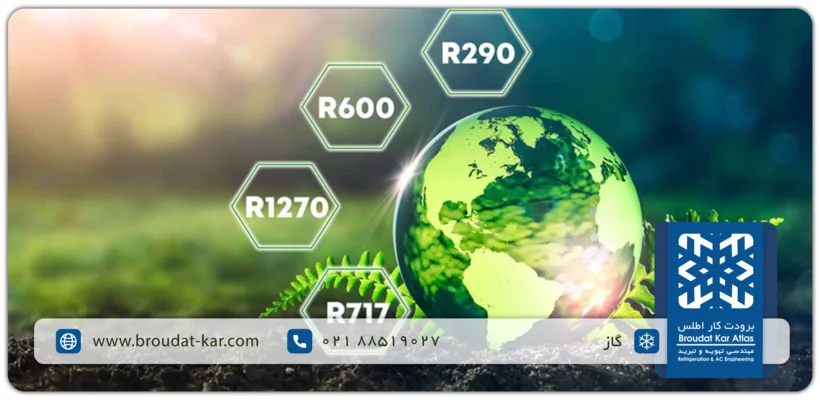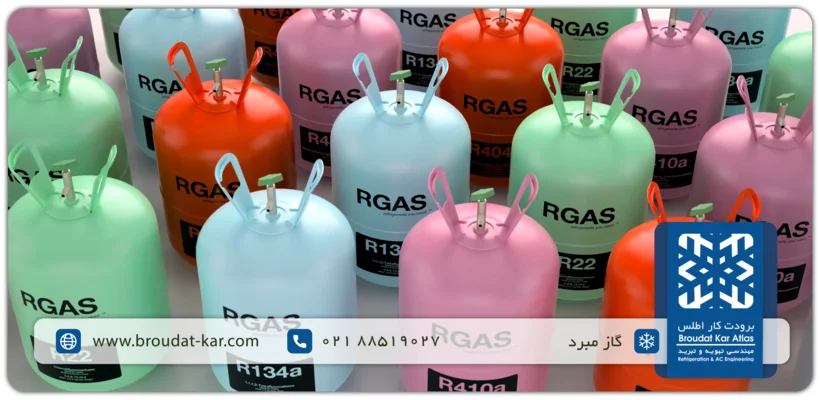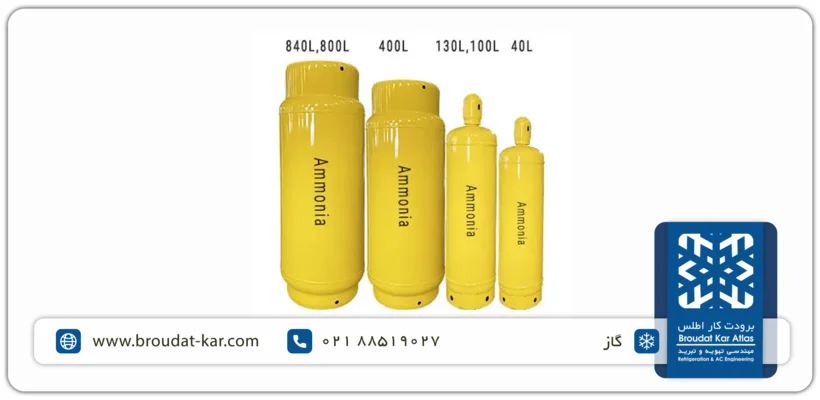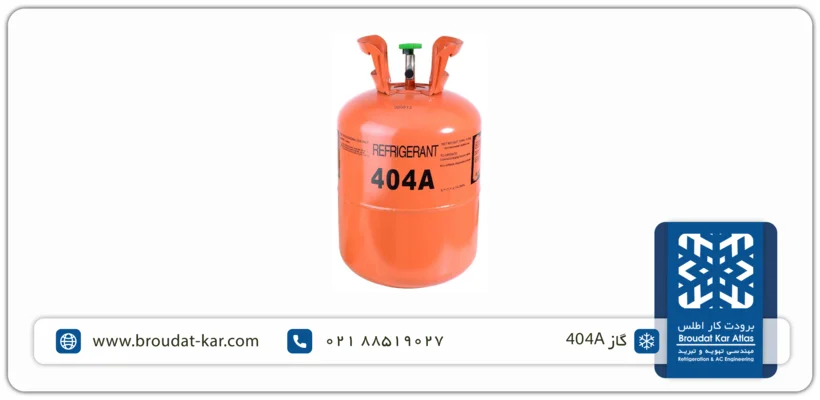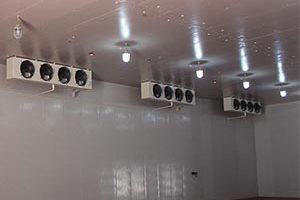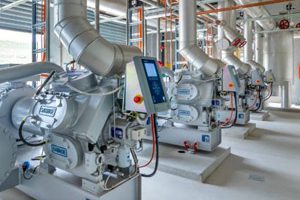What is Refrigerant Gas?
Refrigerant gas, also known as cold storage gas, is a natural or synthetic chemical compound that serves as a fluid in refrigeration and air conditioning systems to transfer heat from one place to another. Refrigerant gases, or cold storage gases, absorb and release heat through phase changes between liquid and gas states, creating cooling or heating processes in these systems.
Refrigerant gas plays a crucial role in cooling and heating systems as a fluid. Refrigerants, or cold storage gases, are vital in shaping the storage of food, maintaining the temperature of residential and commercial spaces, and managing industrial processes. This article will first introduce the history and emergence of refrigerant gas, followed by an introduction to various types of refrigerants. Then, we will discuss the pros and cons of refrigerant gases, considering factors like efficiency, environmental impacts, and safety, while also addressing the cost of cold storage gas.
The Role of Refrigerant Gas in Ventilation and Refrigeration
Refrigerant gases play an important and fundamental role in cold storage rooms, chillers, and overall ventilation and refrigeration systems, which we will explain further.
Refrigerant gas or refrigerant, also known as cold storage gas, acts as a medium by absorbing heat from the environment, water, or any other fluid at a lower temperature. It then expels this heat to another location with a higher temperature (usually the surrounding environment) through aseries of processes in the refrigeration cycle, including compression, condensation, expansion, and evaporation.
Therefore, refrigeration and air conditioning units operate by circulating refrigerant in the refrigeration cycle to achieve the desired temperature. The refrigerant undergoes phase changes (from liquid to gas and vice versa) in heat exchangers (evaporators and condensers). This phase change allows the refrigerant to absorb heat during evaporation in the evaporator and release heat during condensation in the condenser, thereby enabling heat energy transfer in systems like cold storage or chillers.
History of Refrigerant Gas
The historical evolution of refrigerants is a fascinating story that reflects technological advancements, environmental concerns, and the quest for more efficient and safer refrigeration and cooling solutions. Here’s an overview of the key stages in the development of refrigerants:
Early Cooling Methods
Before the 19th Century: Prior to the 19th century, natural methods such as ice harvesting, evaporating cold water, and even underground storage were commonly used for cooling purposes.
Early 19th Century: Pioneers like Michael Faraday experimented with liquefying gases, laying the foundation for modern refrigeration through numerous trials.
Introduction of the First Refrigerants
Mid to Late 19th Century: During this period, the first chemical compounds used as refrigerants, including methyl chloride, sulfur dioxide, and ammonia, were introduced in refrigeration systems.
Late 19th Century to Early 20th Century: The use of toxic or flammable refrigerants led to accidents and safety concerns, sparking research for safer, alternative refrigerants.
The Birth of CFCs and Freon
Early 20th Century: In the 1920s, American chemical engineer Thomas Midgley Jr. produced chlorofluorocarbons (CFCs) like Freon. CFCs gained popularity due to their non-toxic properties and excellent stability, revolutionizing refrigeration and air conditioning systems.
Mid-20th Century: CFCs were widely used in refrigeration, air conditioning, and aerosol propellants due to their excellent properties.
Environmental Concerns and Regulatory Changes
1970s to 1980s: Scientists discovered that CFCs were depleting the ozone layer, which led to the introduction of the Montreal Protocol in 1987.
Transition to Environmentally-Friendly Refrigerants
Late 20th Century to Present: The gradual phase-out of CFCs (like R-11) and later HCFCs (like R-22) accelerated the development and adoption of environmentally friendly refrigerants.
Rise of HFCs and Natural Refrigerants: Hydrofluorocarbons (HFCs) such as R-134a replaced CFCs and HCFCs, but these refrigerants also have high global warming potential (GWP). Meanwhile, natural refrigerants like ammonia (R-717), carbon dioxide (R-744), and hydrocarbons have gained attention due to their minimal environmental impact.
Embrace of Natural Refrigerants and Future Trends
Today: Due to their low GWP and Ozone Depletion Potential (ODP), there is a growing shift towards natural refrigerants. Ammonia (NH3), carbon dioxide (CO2), and hydrocarbons are used in various applications, with innovations and advancements improving their efficiency and safety.
As a result, the historical evolution of refrigerants represents a continuous effort to balance technological innovation, safety, and environmental impacts. From early natural methods to synthetic CFCs and the subsequent move towards environmentally-friendly alternatives, this journey highlights the industry’s responsiveness and commitment to environmental challenges and the ongoing pursuit of sustainable cooling solutions.
Types of Refrigerant Gases (Types of Cold Storage Gases)
Chlorofluorocarbons (CFCs)
CFCs were among the first synthetic refrigerants. They were highly efficient but were found to play a significant role in ozone depletion. Due to their harmful environmental effects, particularly on the ozone layer, their production has been globally halted.
Hydrochlorofluorocarbons (HCFCs)
HCFCs were introduced as a replacement for CFCs due to their lower ozone depletion potential. However, they still have ozone-depleting properties, albeit to a lesser extent than CFCs. HCFCs like R-22 are being phased out under international agreements like the Montreal Protocol.
Hydrofluorocarbons (HFCs)
HFCs emerged as replacements for CFCs and HCFCs due to their zero ozone depletion potential. However, while they do not harm the ozone layer, many HFCs have high global warming potential (GWP), contributing to the intensification of climate change. Efforts to find low-GWP alternatives to HFCs continue.
Hydrocarbons (HCs)
Hydrocarbons are natural refrigerants, including compounds like propane, isobutane, and propylene. They have low environmental impact, low GWP, and excellent thermodynamic properties, making them increasingly popular in power plant and refinery refrigeration systems. However, due to their high flammability, the use of these refrigerants requires careful handling and specific safety measures, which may make them unsuitable for commercial use or simpler industries.
Natural Refrigerants
Ammonia (NH3): Ammonia is an efficient and cost-effective refrigerant with zero ozone depletion potential and very low GWP, widely used in industrial refrigeration systems. However, ammonia gases are toxic and flammable at high concentrations, but thanks to its strong odor, this refrigerant is usually easily detectable and manageable before reaching dangerous concentrations.
Carbon Dioxide (CO2): Carbon dioxide has recently gained significant attention as an environmentally friendly refrigerant with zero ODP (Ozone Depletion Potential) and relatively low GWP (Global Warming Potential). CO2 is used in commercial and industrial refrigeration systems. However, due to the high operating pressure of this refrigerant, it requires modifications to the system and the use of more specialized equipment, which, unfortunately, is not yet accessible in Iran.
Comparison of Refrigerant Types (Types of Cold Storage Gases)
Comparison of Refrigerant Efficiency
Refrigerants differ in their thermodynamic properties, which significantly impact their efficiency in heat transfer and energy consumption. Factors such as specific heat capacity, latent heat, and pressure-temperature relationships affect their performance in refrigeration systems. The most efficient refrigerants are as follows:
- Carbon Dioxide (R-744)
- Propane (R-290)
- Isobutane (R-600a)
- Ammonia (R-717)
- CFC
- HFC and HCFC, depending on the exact type of refrigerant and operating conditions, sometimes one is more efficient than the other.
Source: International Institute of Refrigeration (IIR)
Comparison of Environmental Impacts
The evaluation of refrigerants involves considering their Ozone Depletion Potential (ODP) and Global Warming Potential (GWP). While some refrigerants have zero ODP, others may have very high GWP, which contributes to the intensification of climate change.
Comparison of Safety Considerations
The use of refrigerants like propane, isobutane, and hydrocarbons requires strict safety measures due to their flammability, including ATEX standards. This makes them more suitable for larger industries such as power plants or refineries. Carbon dioxide (CO2) refrigerant has a high operating pressure, so it requires higher-pressure storage tanks, compressors, and valves, which makes maintaining these systems somewhat challenging. Ammonia (NH3) can be toxic and flammable at high concentrations in the air, requiring careful monitoring for leaks and their resolution. Synthetic refrigerants like HFCs are less flammable, but due to their colorless and odorless nature, leak detection sensors should be used in enclosed spaces.
Ultimately, understanding the differences between these refrigerant gases helps in selecting the most suitable refrigerant for specific applications, considering environmental impacts, efficiency, and safety requirements.
Refrigerant Properties
A thorough understanding of refrigerant properties is crucial for achieving a sustainable refrigeration system. Thermodynamic properties, chemical characteristics, and suitability for specific applications are the most important properties of each refrigerant.
Thermodynamic Properties of Refrigerants
The key thermodynamic properties of a refrigerant are its pressure-temperature relationships, heat transfer capacity, and the ability to transfer heat. These properties are essential for ensuring the refrigerant operates effectively within a refrigeration system.
Pressure-Temperature Relationships of Refrigerants
Refrigerants operate within specific pressure and temperature ranges that are vital for their effective performance in refrigeration systems. Understanding these relationships enables technicians and engineers to select the appropriate refrigerant for the desired operating range and ensure optimal system performance. Pressure variations directly correspond to temperature changes, which significantly impact the refrigerant’s phase transition and heat absorption or rejection.
Heat Transfer Capacities of Refrigerants
The ability of refrigerants to transfer heat is crucial for their role in the refrigeration cycle. Heat transfer capacities vary between refrigerants and directly impact the overall system efficiency. A refrigerant’s ability to absorb heat during evaporation (in the evaporator) and release it during condensation (in the condenser) determines its effectiveness and efficiency in thermal energy transfer.
Chemical Properties of Refrigerants
The chemical properties of refrigerants are important for several reasons. The stability and resistance to chemical breakdown or reactions within the system are critical. Additionally, the compatibility of the refrigerant with the materials used in the refrigeration system is also a crucial consideration.
Chemical Stability of Refrigerant Gases
The stability of refrigerants in a refrigeration system is crucial for the system’s stable operation and longevity. Stability includes the refrigerant’s resistance to chemical degradation, breakdown, or reactions within the system. Therefore, the refrigerant should be a stable compound that does not react with other components of the system.
Compatibility of Refrigerant Gas with Materials
Refrigerants come into contact with various system components such as seals, pipes, and compressor parts. Ensuring compatibility between the refrigerant and these materials is essential to prevent corrosion, degradation, or damage. Compatibility issues can lead to leaks, inefficiency, or failure of the system, which emphasizes the importance of selecting refrigerants that are compatible with the system materials.
Suitability of Refrigerant for Use
Generally, it is important to consider that the refrigerant gas used should align with the operating and maintenance conditions, and its selection should be technically justified in terms of efficiency and safety. For example, for small refrigeration systems, it is usually safer and more efficient to use refrigerants like Freon. However, in industrial and large-scale refrigeration systems, these refrigerants are not suitable due to limitations and efficiency concerns.
Best Practices and Considerations for Refrigerant Gas or Cold Storage Gas
Proper Management and Disposal of Refrigerants
Proper management and disposal of refrigerants have environmental and occupational safety implications. Technicians and specialists working with refrigeration and air conditioning systems must adhere to industry best practices, including the use of specialized equipment and compliance with protocols for working with refrigerants. Ensuring controlled containment and release of refrigerants during servicing, maintenance, or decommissioning helps prevent environmental contamination and minimize safety hazards. Additionally, responsible disposal methods, such as refrigerant recovery or recycling, provide a sustainable way to prevent harmful emissions of refrigerants into the atmosphere.
Compliance with Regulations and Certification
Adherence to regulatory standards and obtaining necessary certifications in the refrigeration and air conditioning industry can significantly contribute to ensuring the safety of the system. Compliance with local, national, and international regulations ensures that refrigerant management and system performance align with environmental and safety guidelines. Staying updated with evolving regulations and certifications is critical to maintaining industry standards and ensuring safe and environmentally-friendly practices.
Maintenance Techniques and Leak Detection
Regular maintenance and leak detection are crucial for the efficient and safe operation of refrigeration systems. Conducting routine inspections, leak detection methods, and preventive maintenance programs helps identify and resolve refrigerant leaks quickly, minimizing environmental impact and system inefficiency. Using advanced leak detection technologies, such as ultrasonic or infrared detection, helps detect leaks early, prevent potential hazards, and reduce refrigerant waste.
How to Select Refrigerant for a Refrigeration System
Choosing the right refrigerant for a system is influenced by various factors, including system requirements, environmental regulations, efficiency, safety considerations, and material compatibility. The selection process involves evaluating thermodynamic properties, such as pressure-temperature relationships and heat transfer capacities, to ensure optimal performance and efficiency within the desired operating range. Additionally, assessing environmental impacts, such as Ozone Depletion Potential (ODP) and Global Warming Potential (GWP), is essential for aligning with sustainability goals and regulatory requirements. Safety considerations, such as flammability and toxicity, require a thorough risk assessment and adherence to safety standards to ensure operator and personnel well-being. Material compatibility is crucial to prevent corrosion, degradation, or leaks that could jeopardize the system’s integrity and performance. Ultimately, choosing the appropriate refrigerant involves balancing performance, environmental impacts, safety, and regulatory compliance to achieve optimal refrigeration or air conditioning system performance and sustainability.
How to Replace and Charge Gas
Replacing and charging refrigerant involves safely recovering the existing refrigerant, evacuating the system to remove contaminants, and adding the correct amount of new refrigerant. Technicians use specialized equipment to recover refrigerant, create a vacuum to remove moisture and air, and accurately measure and add the new refrigerant. By accurately measuring the system pressure (which depends on the refrigerant type and operating temperature), optimal system performance can be achieved. Additionally, documenting the steps taken, including the type and amount of refrigerant used, is important for future compliance. This process ensures that refrigeration and air conditioning systems are not charged with the wrong refrigerant, comply with environmental regulations, and minimize environmental impacts.
Refrigerant Gas Price
The price of refrigerant gases, or cold storage gases, varies depending on the type. Some of them come in cylinders of 13.5 kg, 11.5 kg, and 40 kg. For example, refrigerant R-22 is available in 13.5 kg cylinders, R-134a in 11.5 kg cylinders, and ammonia in 40 kg cylinders. Ammonia is also sold in tankers with trailers, and its pricing depends on the amount charged in the system, measured in kilograms. A table with refrigerant gas prices in the Iranian market is provided below. For more information on prices and specifications, please contact our experts.
Final Words
In conclusion, the world of refrigerants is rapidly evolving, shaped by a dynamic interaction of technological advancements, environmental awareness, and regulatory frameworks. From the gradual phase-out of CFCs and HCFCs to the widespread use of HFCs and the revival of environmentally friendly natural refrigerants, the refrigerant landscape is shifting towards sustainability. Choosing a refrigerant now involves a precise balance of efficiency, safety, and environmental impact. As we navigate the complexities of this ever-changing field, ongoing research and development promise innovations that will redefine our approach to heating and cooling systems, ensuring a future where refrigeration aligns seamlessly with environmental responsibilities and technological progress.
When reducing environmental impact and energy costs over the system’s lifetime is more important than ease of installation, and when the operating team has sufficient training to handle these refrigerants safely.
Because the main cost comes from energy consumption during the system’s lifetime. A refrigerant with higher efficiency, even if more expensive upfront, will be more economical overall.
Refrigerant should be charged gradually, and the final amount adjusted according to operating pressures, liquid and suction line temperatures, and proper control of superheat and subcooling.
By using high-quality valves and fittings, performing leak tests during installation, deep vacuuming before charging, and routine servicing that checks joints and filters.
It may require changing the compressor oil, replacing certain seals and O-rings, and adjusting the expansion valve or pressure controls.
Begin by defining the required cooling capacity and temperature conditions. Then evaluate energy efficiency, environmental impact, safety, and compatibility with system components to choose the most suitable option.
Related posts
Refrigerant Gas
Portable Cold Store; Design and Construction of Portable Cold Store + Price The portable cold room, also known as
What Is Meat Cold Storage? Meat cold storage, also known as a meat refrigeration facility, is a specialized center dedicated
What is dairy cold storage? Dairy cold storage stands as a pivotal element within the dairy industry, crucial for the
What Is Chicken Cold Storage? Chicken cold storage refers to specialized equipment designed for preserving poultry products like chicken
Fish and Shrimp Cold Storage Systems – Preserving Freshness Fish and shrimp cold storage facilities play an important role in
What is Fruit Cold Storage? A Fruit cold storage is a specialized facility designed to store fruits and vegetables
Related posts
Refrigerant Gas
What Is a Above Zero cold storage? A Cold Store Above Zero is an insulated space designed for storing products
What is a Freon Cold Store? A freon cold store, is a cooling appliance that utilizes Freon refrigerant within its
What is a freezing cold room? A freezing cold room is a specially insulated space designed to maintain temperatures between
Introduction to Ammonia Refrigeration Systems – Properties, Applications, and Equipment Overview Ammonia, with the chemical formula NH3 and the refrigerant
